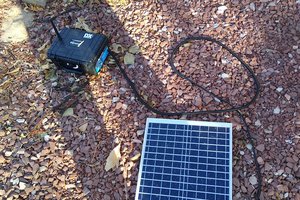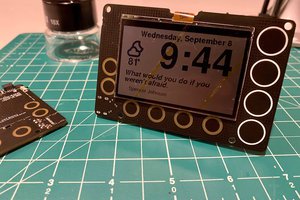The background for this project is that I recently started to surfski, which is paddling a high-performance sit-on-top kayak in the open ocean. The more wind and waves the better because that's where it is the most fun: surfskis are deigned specifically for surfing waves in the open ocean. With this activity come several challenges, in particular safety and tracking one's performance in order to learn and improve. Despite first appearances, it's a very technical sport and there is a lot to learn both about stroke technique as well as wave riding skill.
Most surfskiers use a GPS watch, e.g. a Garmin or similar, attached to the foot strap. Looking at the prices and limitations of these things, plus the fact that one ends up tied into some vendor's tracking platform made me want to build my own. There are also a few more specialized trackers, such as SpeedCoach or from Vaaka, but they're very pricey and don't provide a real-time connection for someone on shore to track from a safety point of view.
I tried to use an Android phone for many months and have concluded that it just doesn't work. Right off the bat the battery life doesn't make it. I use an excellent GPS tracking app designed to track family members and it works beautifully as long as the phone screen is off and tucked in my PFD. But it provides no real-time information about the speed I'm going at, my heart rate, etc. If I use a sports tracking app that displays this type of data and mount the phone so I can see it then the battery lasts at best for an hour. Plus Android tries hard to terminate the app to save battery. It has been an exercise in frustration!
=== Goals ===
So I thought "how hard can it be?" :-). The minimal goals I set for the tracker are the following:
- track the activity in real-time using GPS plus a heart rate monitor and display speed, time, distance, and heart rate in real-time on a screen mounted to the footstrap
- send the tracking info in real-time via LoRa and/or 4G LTE to my own server and display progress on a map with some additional info useful for safety (heart rate, current speed, etc)
- the enclosure must be waterproof for shallow immersion, the screen must be legible in full sunlight, and the battery has to last comfortably for 2 hour outings
I have some additional stretch goals:
- display min/max speed so I can see the acceleration going down a wave and the slow-down hitting the back of one
- determine paddle stroke parameters, such as stroke rate, stroke distance, etc. using either boat acceleration or a paddle mounted sensor
- determine wave parameters, such as wave height, speed frequency using an accelerometer
=== Initial prototype ===
The initial prototype I build consists of a number of parts I cobbled together from previous projects:
- Small stm32L082 board (Jeenode) with Hoperf RFM98 433Mhz LoRa radio
- Globaltop PA6H GPS on adafruit breakout board
- Bosch BNO055 compass, accelerometer, gyro on Adafruit breakout board
- Small protoboard tieing everything together and having a 16MB SPI flash chip mounted
In addition I added:
- Battery holder for an 18650, with small USB charger board
- Monochrome transflective ("sunlight readable") 128x64 LCD with SPI interface
- HM-11 bluetooth BLE radio to get the heart rate from a polaris 7 heart rate monitor
- Waterproof case with quick latch
I threw the prototype together so I could experiment with a number of pieces:
- How well does the GPS track quick accelerations and decelerations (the Garmin phones tend to be really sluggish, the tracker in my Android phone reliably records impossible speed bursts). I figured I might have to try a couple of different GPS devices in order to find one that works for the purpose.
- Can I make the LoRa link work? I live about 10 miles (16km) away from the harbor where I usually paddle and at an altitude of 2100ft (about 650m) where I have line of sight. But that's quite a distance and starts to cut into speed vs...
Read more » Thorsten von Eicken
Thorsten von Eicken
 Dan Fay
Dan Fay


 Darian Johnson
Darian Johnson